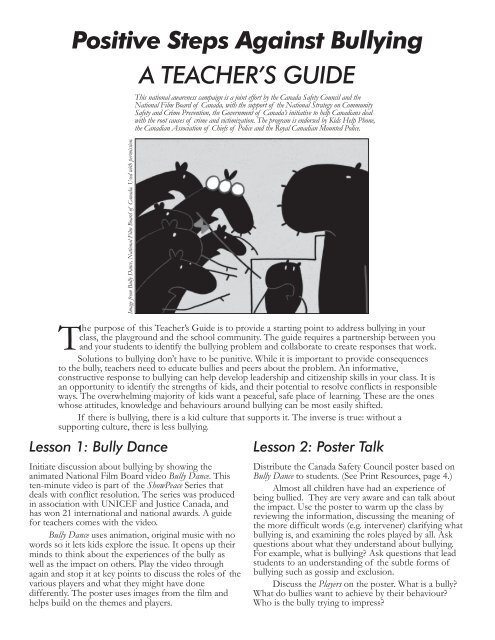Positive Steps Against Bullying A TEACHER'S GUIDE - Bullfrog Films
Positive Steps Against Bullying A TEACHER'S GUIDE - Bullfrog Films
Positive Steps Against Bullying A TEACHER'S GUIDE - Bullfrog Films
You also want an ePaper? Increase the reach of your titles
YUMPU automatically turns print PDFs into web optimized ePapers that Google loves.
<strong>Positive</strong> <strong>Steps</strong> <strong>Against</strong> <strong>Bullying</strong>A TEACHER’S <strong>GUIDE</strong>Image from Bully Dance, National Film Board of Canada. Used with permission.The purpose of this Teacher’s Guide is to provide a starting point to address bullying in yourclass, the playground and the school community. The guide requires a partnership between youand your students to identify the bullying problem and collaborate to create responses that work.Solutions to bullying don’t have to be punitive. While it is important to provide consequencesto the bully, teachers need to educate bullies and peers about the problem. An informative,constructive response to bullying can help develop leadership and citizenship skills in your class. It isan opportunity to identify the strengths of kids, and their potential to resolve conflicts in responsibleways. The overwhelming majority of kids want a peaceful, safe place of learning. These are the oneswhose attitudes, knowledge and behaviours around bullying can be most easily shifted.If there is bullying, there is a kid culture that supports it. The inverse is true: without asupporting culture, there is less bullying.Lesson 1: Bully DanceThis national awareness campaign is a joint effort by the Canada Safety Council and theNational Film Board of Canada, with the support of the National Strategy on CommunitySafety and Crime Prevention, the Government of Canada’s initiative to help Canadians dealwith the root causes of crime and victimization. The program is endorsed by Kids Help Phone,the Canadian Association of Chiefs of Police and the Royal Canadian Mounted Police.Initiate discussion about bullying by showing theanimated National Film Board video Bully Dance. Thisten-minute video is part of the ShowPeace Series thatdeals with conflict resolution. The series was producedin association with UNICEF and Justice Canada, andhas won 21 international and national awards. A guidefor teachers comes with the video.Bully Dance uses animation, original music with nowords so it lets kids explore the issue. It opens up theirminds to think about the experiences of the bully aswell as the impact on others. Play the video throughagain and stop it at key points to discuss the roles of thevarious players and what they might have donedifferently. The poster uses images from the film andhelps build on the themes and players.Lesson 2: Poster TalkDistribute the Canada Safety Council poster based onBully Dance to students. (See Print Resources, page 4.)Almost all children have had an experience ofbeing bullied. They are very aware and can talk aboutthe impact. Use the poster to warm up the class byreviewing the information, discussing the meaning ofthe more difficult words (e.g. intervener) clarifying whatbullying is, and examining the roles played by all. Askquestions about what they understand about bullying.For example, what is bullying? Ask questions that leadstudents to an understanding of the subtle forms ofbullying such as gossip and exclusion.Discuss the Players on the poster. What is a bully?What do bullies want to achieve by their behaviour?Who is the bully trying to impress?
<strong>Positive</strong> <strong>Steps</strong> <strong>Against</strong> <strong>Bullying</strong> 2 Canada Safety CouncilHow do boys bully? How do girls bully? Payparticular attention to Bystanders. What role do they playin bullying? Bystanders are watchers. Just by watching,young people become part of bullying. In fact, watchersinadvertently support it; after all, bullies need anaudience. Explain that watching without interveningreinforces bully behaviour.Question children about the motivation of thebully (i.e. to look powerful) and the long-termconsequences of their violent behaviors for them: theymay be punished, lose friends, or people become afraidof them. Bullies are not liked.Have the children identify the consequences ofbeing bullied: depressive thoughts, isolation, constantfear, inability to concentrate, feeling of being worthless.Now use the Action section of the poster to discussresponses to bullying. Explain the roles of adults in preventingbullying and the need for kids to report incidents.Discuss the role of the intervener, someone whoacts to end the bullying. It can be a parent or anotherchild. The point is to intervene in pro-social ways, notby simply confronting the bully, but by showingleadership and positive ways to resolve disputes.Talk about resources for kids in trouble. Kids HelpPhone numbers and Internet address are on the poster.Kids Help provides excellent resources for kids whoneed to share problems in a moderated chat, or discussproblems with counselors.Lesson 3: Bully TalkIt’s important to help children tune into their feelingsabout bullying. Some might regard bullying as theatre orexcitement on the playground. They need insight intothe reality that other kids are getting hurt. They need tosee things from the victim’s perspective.Set some ground rules for the discussion: you arenot asking the class to blame anyone, so no individualsare to be named. Then ask some questions aboutbullying around the school. Who has seen bullying?How did they know it was bullying? What kind ofbullying was it? Were there bystanders? What do bystandersdo? I.e. were they helpful to the bully or thevictim? How can bystanders play a role to stop bullying?Help your students identify strategies for dealingwith bullies. Look for pro-social responses to bullying,strategies that are safe and effective. CAUTION: Manykids will come withIntervention is effective:research shows that whenchildren intervenebullying ends within 10seconds every other time.‘bully the bully’solutions. Encouragethem to think of other,pro-social ways they canintervene. Ask thechildren what mighthappen if the victimtries to bully the bully.One group of kids may decide to just peek atbullying incidents, then turn their backs and ignore thebully. They could remove the victimized child from thesituation, inviting him or her to play. They could get anadult. A group of friends could stand up and help thevictim. They could distract the bully.Encourage kids to speak up against bullying and toget an adult to intervene when they witness it.Be clear about the role of adults in dealing withbullies but also trust the kids to come up with their ownsolutions. The reality is they don’t usually call on adults.But if you encourage them, they’ll probably come upwith peer mediation ideas that are responsible, safe andlikely to be done.Talk to them about intervention. They may beafraid to intervene, and that’s okay. They need to bereminded that they should not put themselves in danger.How can they intervene without becoming a victimthemselves? What can they do if they do not feel safeintervening themselves? There is a need to talk aboutthe “secrecy” of bullying – the threats that bullies maketo keep others silent – and the need to break down thecode of silence.ActivityDivide the class into small groups and ask each group toimagine a situation between a bully and a victim. Theycan base their scenarios around real bullying incidents.Ask students to work through different responses tobullying in each situation. Each group can report to theclass on how they solved a bullying problem, or they canpresent stories or improvised role-plays that rehearseresponses to bully behaviour. Ask the class to vote onthe responses that seem to work the best.Lesson 4: Bully AuditOnce you have identified bullying as an issue, work withyour class to gather more information about it. This isan opportunity for teacher reflection on systemic issuesaround bullying. For example, is there a school policyabout bullying? Is it consistently enforced in your classand on the playground?Report BoxCreate a box where bullying incidents can be reported.However, bear in mind that once the class has createdthe box, the teacher takes responsibility for respondingto incident reports.SurveyStudents working in groups can develop questions for aquestionnaire on bullying. Keep the questions to just afew. You may want to limit the number of questions inadvance. The group has to create a questionnaire, thensurvey the class or beyond the class and gather thefigures and information on bullying together. Have each
<strong>Positive</strong> <strong>Steps</strong> <strong>Against</strong> <strong>Bullying</strong> 3 Canada Safety Councilgroup present its report. Discuss the reports with thewhole class. Use the data to integrate some math skills.Try to bring the stats alive, perhaps by having a groupof 10 students demonstrate — for example, three outof ten step forward to represent that 30 percent ofstudents have been bullied.Map of Bully BehaviourHave groups of students work to draw a map of theschool and schoolyard, then plot bullying incidents onthe map. Use the completed map to talk about hotspots,and places to avoid or frequent only with friends.Follow-up• From time to time after a recess, ask about bullying.If it happened, let the students know you aremonitoring the problem and are concerned about it.• Ask the kids to use a different strategy the next timebullying happens, then ask them to report to the classon how it worked.• Teachers need to find opportunities to talk aboutpower, control, aggression, and inclusion / exclusionthroughout the year. Follow-up discussions can drawchildren’s attention to ways to promote inclusion andsafety in the class and school.• Perhaps the results of working with your students willconvince you that you need to get together with otherteachers and the principal to work on the bullyingissue. Probably, you should be working with theparents too. In any case, you’ll need to call up moreexpert resources if the problem is serious. You canbegin with the resources listed in this guide but alsolook for helpers from within your school and schoolboard, and your community policing officer.Building an Anti-<strong>Bullying</strong> StrategyWhat should teachers do to address bullyingproblems? Here are some steps to help you deal withbullying in your school.Short-termEven when you didn’t actually witness an incident ofbullying, you can always respond. Support the victim.Students seldom make up stories about bullying. Talkto the young person about what they are feeling. Talkto them about what they can do differently to changethe situation. Bear in mind that there is sometimesvery little that victims can do to extract themselves –the bully has so much power. Let them know thebehaviour is unfair and not right.• Talk to the victim’s parents. Express concern anddetermination to take action.• Identify the bully.• Identify the peer group that is backing the bullyand discuss with the individuals their role inbullying.• Take the child who bullied to the principal’s office.• Find out if your school has a bullying problem byusing the Bully Audit in this Teacher’s Guide.Ask these questions:• Does this school have a policy on bullying?• If so, is it enforced?• Does the school effectively monitor bullyingeverywhere on the premises?• Does the school record and follow up all bullyingincidents?• Is counselling and support provided to participantsin bullying incidents (bullies, victims andbystanders)?• Does the school work with parents to deal withbully behaviour?If the answer to any of these questions is “NO,”your school needs to do some more work around theissue of bullying. See the list of resources at the endof this guide.Long-term• Bring together bullies and bystanders to discusstheir responsibilities, the problem and theconsequences.• Work with administrators, other teachers, adultsupervisors on the playground, parents, andneighbourhood representatives to developguidelines for behaviours, solutions for bullyingproblems, and potential consequences if bullyingcontinues.• Develop school procedures to guide teachers inresponding to bullying incidents.• Have a program to promote pro-social behavioursand conflict resolution in the school.• Check in with the victim to ensure that this orother problems do not persist.• Influence the peer group. Use the Talk about<strong>Bullying</strong> section of this Teacher’s Guide to discussbullying with the class.• Teachers should reflect on their own behaviour. Isthere anything that the teacher does to modelbullying for the children?• Watch and listen for even minor forms of bullyingand intervene on each occasion.Research shows teachers intervene inonly 18 per cent of bullying incidentsin the classroom.
<strong>Positive</strong> <strong>Steps</strong> <strong>Against</strong> <strong>Bullying</strong> 4 Canada Safety CouncilPrint ResourcesBully Dance posters are available free of charge from theCanada Safety Council: fax (613) 739-1566; telephone(613) 739-1535, ext. 228; e-mail csc@safety-council.orgParentbooks has many books on bullying for teachers,parents and children available from its web site at:www.parentbookstore.com/index.html or you can e-mail them for a book list at parentbk@netcom.caRecommended:Keith Sullivan, An Anti-bullying Handbook. New York,Oxford University Press, 2000.Carla Garrity et al, Bullyproofing Your School: AComprehensive Approach for Elementary Schools. Longmont(Colorado), Sopris West, 2000Sharpe and Smith, Tackling <strong>Bullying</strong> in Your School. NewYork, Routledge,1994.Internet Resourceswww.crime-prevention.org/english/publications/children/violenceThis Government of Canada site outlines bullying andvictimization. The site examines characteristics ofbullies and victims and discusses the roles of students,teachers, parents, and schools.www.ianr.unl.edu/pubs/family/nf309.HTMThe page speaks specifically to parents.www.lfcc.on.ca/bully.htmThe London Family Court Clinic provides informationfor parents and teachers about bullying. There are verydetailed suggestions for what parents, teachers, andschools can do about the problem.kidshelp.sympatico.caA site where kids can learn about bullying, and participatein moderated chats on a wide range of topics.www.deal.orgA by-youth-for-youth initiative of the RCMP’s NationalYouth Strategy, includes a section for parents and teachers.www.unicef.caFor additional resources on conflict resolution visitUNICEF Canada’s Global Schoolhouse.www.yorku.ca/lamarsh/articles.htmDownload the document Making A Difference in <strong>Bullying</strong>,a good resource for schools, communities and parents.NFB VideosAnimationBully Dance, from the ShowPeace conflict resolution series(www.nfb.ca/showpeace), shows a bullying situation; noone stops the dance until serious harm is done. Itcompels viewers to take stock of their actions and findways to end peer abuse. (10 minutes)DocumentaryWaging Peace: A Year in the Life of Caledonia Junior Highfollows the transformation of a school in crisis, andhow it started to build a culture of peace. (70 minutes)A sequel, Learning Peace, will be released in 2002. InSticks and Stones, children describe how it feels to beteased when their families don’t follow traditionalgender roles, and talk about name-calling and what canbe done about it. (17 minutes)To purchase NFB videos call 1-800-267-7710 or visitwww.nfb.ca.AcknowledgementsThe Canada Safety Council thanks the following for theirexpert advice in the development of this Teacher’s Guide:Wendy Craig, Ph.D., Department of Psychology,Queen’s UniversityJean Gervais, Ph.D., Département de psychoeducationet de psychologie, Universite du Québec à HullDebra J. Pepler, Ph.D, LaMarsh Centre for Research onViolence and Conflict Resolution, York UniversityThe guide was prepared by Rob McBride, Just SoProductions, for the Canada Safety Council. It is basedon Making a Difference in <strong>Bullying</strong>, a study by Dr. Craigand Dr. Pepler .What goes on in the classroom may contributeto a bullying problem. In fact, researchindicates that bullying occurs about twice anhour in the classroom yet teachers are notaware of most incidents. Teachers have toestablish an environment where respect is showntoward and among learners, and set groundrules to limit put-downs and harassment.© 2001, Canada Safety Councilwww.crime-prevention.orgwww.safety-council.orgwww.nfb.ca/showpeace











